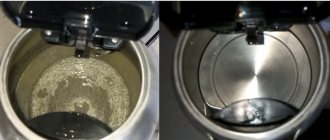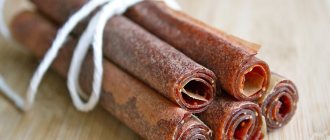The difficulty of removing it is due to the fact that it cannot be removed during normal dishwashing. To do this, you can use home recipes and special household chemicals.
Read the article about how and how to remove scale from a saucepan at home.
Top 3 special tools
If folk remedies are insufficiently effective, store-bought household chemicals designed to remove scale from dishes will come to the rescue.
Antiscale
The special product Anti-Scaling TM Zolushka (manufactured in the Russian Federation) is intended for removing lime deposits from the inner surface of teapots and pans. The exception is enamel cookware, for which this product is not intended.
Advantages of use:
- biodegradability;
- affordable price;
- Ease of use;
- non-toxic;
- efficiency.
Very easy to use:
- Pour cold or warm water into the pan.
- Dissolve the contents of the sachets based on the proportion - 1 sachet per 4-5 liters of water.
- Stir.
- Leave to stand for 20 minutes.
- Rinse.
In addition to pots, Antiscale can be used in electric kettles, regular kettles, and irons. The price per bag is less than 20 rubles.
Chistin Antiscale
The cleaning product produced in the Russian Federation is available in small packages of 75 grams. Chistin can be used to descale teapots, pots, irons, boilers, etc. The product is even suitable for cleaning enamel dishes.
To prepare the solution, dilute the contents of the package in 1 liter of warm (about +40°) water and leave for half an hour . After this, wash the pans with a sponge in running water. The cost of Chistina is about 40 rubles per package.
Romax Boom
The drug TM Romax Boom is available in 0.3 liter bottles. The product is suitable for stainless steel and glass, but cannot be used for cleaning enamel containers.
Application:
- Prepare a solution based on the ratio - 0.5 liters. water – 100 ml Antiscale.
- Pour the solution into the pan.
- Leave to stand without heating for about half an hour.
- Drain the liquid.
- Rinse the pan with water.
The product is produced in Belarus. A bottle costs about 45 rubles.
How to descale a saucepan with citric acid.
If the coating on the inside of the dishes is fragile and easily damaged, you can replace the aggressive vinegar essence with a softer citric acid. “Limonka” copes well with scale and does not affect the main coating of the pan.
- For the hot method, we need 20 g of acid per 1 liter of water. Bring the water to a boil and leave to stand for half an hour. If necessary, repeat the procedure.
- For the cold method, the concentration of citric acid will be required 1.5 - 2 times more. After several hours of “soaking”, the scale can be easily removed with a regular sponge.
Cleaning features depending on the material
When starting to descale pots, you should definitely take into account the material from which they are made. This circumstance cannot be ignored, since violation of the care rules can lead to damage to kitchen utensils.
Aluminum cookware
Aluminum pans, when regularly used for boiling high-hardness water, quickly lose their appearance. This material oxidizes and darkens when exposed to food and water.
For aluminum, good results will be obtained by boiling with brine, using solutions of citric or acetic acid, or using apple peelings.
The peculiarity of the material imposes a number of restrictions on cleaning such pans. All the “don’ts” when removing plaque from aluminum cookware:
- use products with chlorine;
- use abrasives (steel wool, soda, etc.).
Preparations that are intended for dishwashers cannot be used to treat aluminum, as they can react chemically with this metal.
How to remove from enamel?
Convenient and beautiful dishes coated with enamel also begin to become overgrown with lime deposits when water boils . At the initial stage, the salts that form the sediment have a loose consistency, but over time they become hard, worsening the appearance of the dishes.
Many methods are suitable for cleaning, excluding aggressive mechanical action and concentrated acids.
Can be used:
- brine,
- peeling potatoes,
- soda
Cookware with enamel defects on the inside should not be used for cooking.
Made of stainless steel
Stainless steel pans are durable, laconic, and last a very long time. These things are quite easy to take care of. But the problem of scale formation in relation to stainless steel is also relevant.
The ability of the material to withstand the effects of household chemicals allows for effective cleaning. You can use almost any recipe, including: citric acid, baking soda, vinegar, etc.
Basic rules for caring for pots
Removing scale often takes a long time, and dealing with contamination leads to damage and damage to the product. Experts recommend following preventive measures and minimizing the possibility of contamination, since it is always easier to deal with a light coating than with a persistent and neglected one.
- Careful and careful washing of any type of dishes and water filters are the best means of prevention. Forget about boiling tap water.
- Whenever possible, use spring or bottled water when cooking.
- Do not neglect regular cleaning of dishes and kitchen utensils (at least once a month).
- If boiled water has not been used, drain it. Do not reheat boiled water.
- After each use, rinse the dishes with water and wipe dry with soft cloths.
- When washing pots, avoid using any products containing abrasives. Do not use hard brushes or sponges.
- Avoid scratches and damage - such utensils are absolutely not suitable for cooking.
- In order to preserve the coating, eliminate possible temperature changes (hot to cold and vice versa).
To date, there are no known ways, methods and materials when it would be possible to accurately and permanently get rid of scale. But still, following simple recommendations and advice, promptly getting rid of the first signs of contamination, it is realistic and easy to achieve clean dishes and extend their life.
If you know interesting and effective recipes or are ready to reveal your secrets of caring for kitchen utensils, be sure to share them with us!
Prohibitions
In an effort to descale your pots as efficiently and quickly as possible, you need to remember a number of prohibitions when processing.
These include the following:
- Do not use chemicals that are not designed to care for cookware to clean the inside of the pan. Such experiments can not only damage the material of the pan, but also cause harm to health.
- You should also not try to speed up the process by using sharp and abrasive objects (sandpaper, knife, etc.) - the surface can be seriously damaged.
Method No. 6: household chemicals
Of course, in the topic of combating limescale, we cannot fail to mention products specially created for this purpose. Today's stores are filled with a variety of cleaners, the most popular of which are:
- Cillit BANG detergent.
- Cleaner CLEANACID.
- “Master Glitter. Antiscale".
- Doctor Ten descaling agent.
- Sano Anti Kalk.
The main thing when working with such chemistry is to always carefully and thoroughly follow the instructions without disturbing the process, then you will be able to enjoy the fruits of scientific progress and not harm either the dishes or your health.
Any of the methods for dealing with plaque is good, but the best thing is to get rid of it as early as possible, so as not to encounter serious contamination in your beloved and clean kitchen.
Preventive measures: how to prevent the formation of lime deposits?
To reduce the possible likelihood of limescale deposits forming on pots and other utensils, it is advisable to use preventive measures.
These include:
- Using softened water for cooking. This can be achieved by installing a filtration system and using purchased purified water.
- After each cooking, the dishes must be washed thoroughly. In this case, plaque will not accumulate on the walls and bottom.
Method number 2: cleaning
This amazing method came to us from a time when there were no household chemicals in the kitchens, but cleanliness was maintained in every possible way. In order to clean scale at home using potato peelings, you need to rinse them well, add water and boil over low heat for 15-20 minutes. If desired, they can be replaced with apple peels. Despite the environmental friendliness and economy of this method, it may not be effective enough to remove all plaque the first time. If this happens to you, repeat the boiling with fresh peelings again.
Recommendations
Expert advice will help you effectively deal with lime deposits and keep this process under control:
- The intensity of sediment accumulation is directly related to the hardness of the water used.
- Sediment in the pan not only looks unsightly, but also negatively affects your health.
- Timely descaling allows the pan to heat up faster, since due to its physical properties, lime insulates heat, lengthening the cooking process.
- Before you start cleaning the pan, you need to make sure that the chosen method is safe for the coating.
- After cleaning scale using any method (even using food products, such as soda, vinegar, etc.), the surface should be thoroughly washed.
- Most products may not be able to cope with a thick layer of lime the first time. In this case, the procedure will have to be repeated several times.
Keeping your cookware clean not only inside but also outside will extend its life and keep your kitchen appliances hygienic.
This section will tell you about methods for cleaning various household appliances from scale.
How to descale an aluminum pan.
Scale appears on aluminum surfaces much faster than on dishes made from other materials. Aluminum is very soft by nature, so scrubbing it is not recommended. There is a high risk of scratching the surface of the pan. When a thick layer of scale appears, the pan must be boiled in a container filled with a solution of the following ingredients:
- water (10 l.);
- 1 piece of brown laundry soap (grate and dissolve);
- half a pack of soda (it is advisable to take soda ash);
- 100-150 ml. silicate glue.
You need to boil until all the scale is gone. If there is only a little scale, you can use the following composition:
- water (3-5 l.);
- ammonia (5-10 drops);
- laundry soap (small piece);
- soda 1 tbsp. l.
Thoroughly rinse the areas covered with scale with the prepared solution. Vinegar essence has proven itself to be excellent for cleaning aluminum: 3-4 tbsp. l. onto a pan of water. It is enough to boil for 15 minutes and the scale will come off the walls of the pan on its own.
Why is enamel destroyed and what should not be done?
Practical tips will help to keep enamel utensils tidy:
- It is forbidden to put empty dishes on the fire;
- a container with water cannot be placed in the freezer - expanding, the water causes damage to the enamel;
- impacts from falls are fraught with chips that quickly become covered with rust;
- It is not recommended to use metal brushes and brushes for regular cleaning - they damage the coating;
- It is undesirable to use metal spatulas, spoons, or whisks when stirring food - they scratch the surface;
- It is not recommended to place enameled products on a gas burner without a flame divider (due to spot heating, the enamel layer quickly becomes unusable);
- Dishes with enamel cannot withstand sudden changes in temperature, so you cannot take a hot container out into the cold or, conversely, put a cold pan on the fire right away.
How to remove stains from stainless steel?
Dilute white vinegar in water in a ratio of 1:5 and wipe the sink with a microfiber cloth soaked in the solution, and then rinse with clean water. Clean and polish stainless steel in a circular motion to give it an extra shine.
Interesting materials:
How to scroll down on a laptop without a mouse? How to press Page Up on a laptop? How to disable numbers on the keyboard on a laptop? How to switch the keyboard to English on a laptop? How to change the keyboard language on a laptop? How to change the language from Russian to English on a laptop? How to change the system language on a laptop? How to set a password on a laptop when turning it on? How to put a dash on a laptop? How to put a comma on a laptop?










